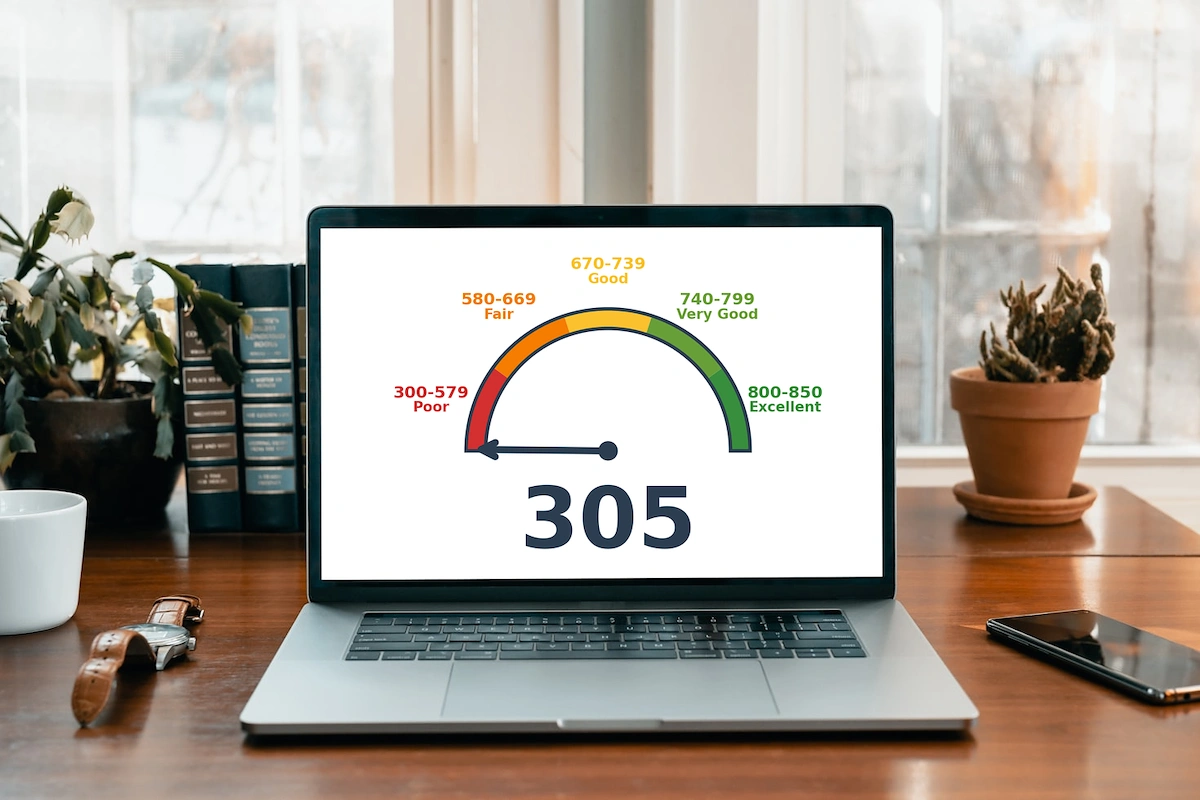
Kudos has partnered with CardRatings and Red Ventures for our coverage of credit card products. Kudos, CardRatings, and Red Ventures may receive a commission from card issuers. Kudos may receive commission from card issuers. Some of the card offers that appear on Kudos are from advertisers and may impact how and where card products appear on the site. Kudos tries to include as many card companies and offers as we are aware of, including offers from issuers that don't pay us, but we may not cover all card companies or all available card offers. You don't have to use our links, but we're grateful when you do!
305 Credit score: What You Need to Know in 2025
July 1, 2025


TL;DR
While a 305 credit score presents a significant opportunity for growth, it provides a clear starting point for improving your financial standing. This score falls into the "Poor" FICO score category, highlighting specific areas to focus on for building a stronger credit profile.
What Does a 305 Credit Score Mean?
A 305 credit score places you in the "poor" range of FICO scores, which run from 300 to 850. This number signals to lenders a history of significant financial challenges, such as delinquencies, collections, or other major negative marks on your credit report. It indicates a very high level of risk to potential creditors, making it one of the lowest scores a consumer can have.
Financially, a 305 score creates substantial hurdles. You'll likely find it extremely difficult to be approved for new loans or credit cards. If you do manage to get approved, it will almost certainly be with unfavorable terms, including very high interest rates and steep security deposits. While this presents a tough financial reality, it is a starting point from which a new path forward can be forged.
Who Has a 305 Credit Score?
According to 2023 Experian data, average credit scores tend to rise steadily with each generation:
- Generation Z (ages 18-26): 680
- Millennials (ages 27-42): 690
- Generation X (ages 43-58): 709
- Baby Boomers (ages 59-77): 745
- Silent Generation (ages 78+): 760
Credit Cards With a 305 Credit Score
A credit score of 305 falls into the "poor" range, which can significantly hinder your ability to qualify for most traditional credit cards. Lenders view this score as a high-risk indicator, making them hesitant to approve applications due to concerns about potential defaults. Consequently, your options will likely be restricted to secured credit cards or specialized cards for bad credit, which may come with higher fees and interest rates.
Tools like Kudos' AI-powered Dream Wallet can help by analyzing your spending habits and financial situation to provide personalized card recommendations. The platform offers features like 'Credit Score and Annual Fee Insights' to clarify how a new card could affect your credit, helping you choose a card that aligns with your journey to rebuild your score.
Auto Loans and a 305 Credit Score
A 305 credit score places you in the deep subprime category, which can make securing an auto loan difficult. While approval is still possible, you will likely face some of the highest interest rates available from lenders.
According to 2025 auto loan data, here is how average rates break down by credit score:
- Super-prime (781-850): 5.25% for new cars and 7.13% for used cars
- Prime (661-780): 6.87% for new cars and 9.36% for used cars
- Non-prime (601-660): 9.83% for new cars and 13.92% for used cars
- Subprime (501-600): 13.18% for new cars and 18.86% for used cars
- Deep subprime (300-500): 15.77% for new cars and 21.55% for used cars
Mortgages at a 305 Credit Score
With a 305 credit score, qualifying for a mortgage is extremely challenging. Most lenders have minimums far above this level for conventional, VA, and USDA loans. Even government-backed FHA loans require a score of at least 500 with a 10% down payment. As such, a 305 score makes approval for nearly any standard home loan highly improbable, placing you well below the threshold for even the most lenient options.
In the rare event you find a specialty lender, your score would lead to highly unfavorable terms. You would face steep interest rates, significantly increasing the total cost of the home over the loan's life. Lenders would also likely require a substantial down payment and charge higher fees to compensate for the lending risk, making homeownership far more expensive.
What's in a Credit Score?
Figuring out what goes into your credit score can feel like trying to solve a complex puzzle, but it generally boils down to a handful of key elements. The most common factors include:
- Your history of making payments on time is the most significant factor.
- How much of your available credit you're currently using, known as your credit utilization ratio, plays a major role.
- The age of your credit accounts, including the average age and the age of your oldest account, is also considered.
- Lenders like to see that you can responsibly manage different types of credit, such as credit cards and loans.
- Opening several new credit accounts in a short period can be seen as a risk and may temporarily lower your score.
How to Improve Your 305 Credit Score
Don't be discouraged by a 305 credit score; with consistent positive behavior, it's possible to see meaningful improvements. According to one expert guide, most people can see significant changes within three to six months by taking the right steps.
- Establish Automatic Bill Payments. Since payment history is the most significant factor in your credit score, setting up automatic payments is a critical first step. This ensures you build a record of on-time payments, which is essential for rebuilding from a very low score.
- Apply for a Secured Credit Card. A secured card requires a cash deposit as collateral and is designed for those building or rebuilding credit. Making regular, on-time payments on a secured card that reports to the major bureaus is a powerful way to establish a positive history when other options are limited.
- Reduce Your Credit Utilization Ratio. This ratio measures how much of your available credit you're using, and keeping it below 30% is key. For a low score, paying down balances is a high-impact action that shows lenders you can manage credit responsibly.
- Become an Authorized User. Being added to a credit card account of a trusted person with a strong payment history allows you to benefit from their good habits. Their positive account history can be added to your credit file, helping to improve your score.
The free Kudos browser extension can help you manage your cards and track your progress as you build better credit habits.

Supercharge Your Credit Cards
Experience smarter spending with Kudos and unlock more from your credit cards. Earn $20.00 when you sign up for Kudos with "GET20" and make an eligible Kudos Boost purchase.
Editorial Disclosure: Opinions expressed here are those of Kudos alone, not those of any bank, credit card issuer, hotel, airline, or other entity. This content has not been reviewed, approved or otherwise endorsed by any of the entities included within the post.




























.webp)
.webp)
.webp)
.webp)
.webp)

.webp)
.webp)
%20(1).webp)
.webp)